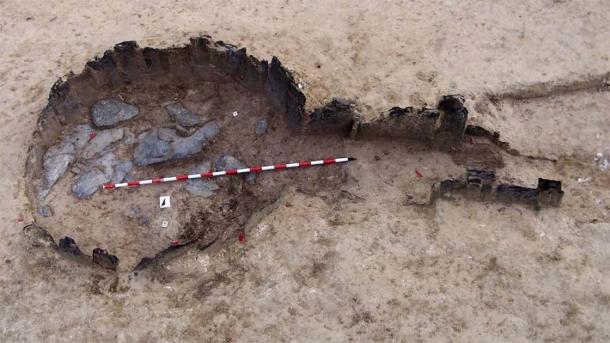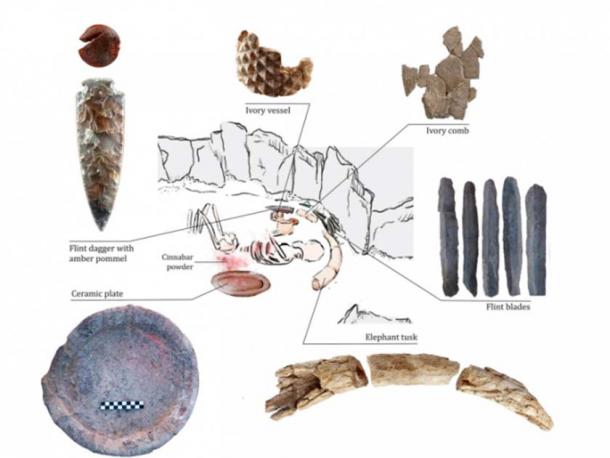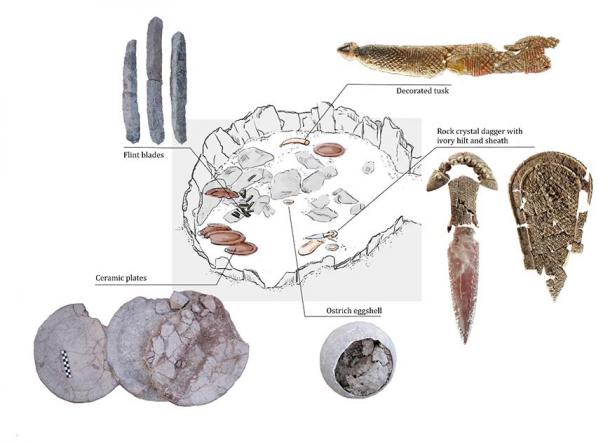
High Status Skeletal Find of “Ivory Man” in Valencia Turns out To Be “Ivory Lady”
In 2008, in southwest Spain’s Valencia, the skeletal grave of an ‘important person’ was undoubtedly found, with an array of precious artifacts. This included an elephant's tusk, an ivory comb, a crystal dagger, an ostrich eggshell, and a flint dagger adorned with amber. Classified initially as "probable young male" between the ages of 17 and 25, based on pelvic bone analysis, the moniker “Ivory Man” was bestowed upon this find. But now, new information has emerged that shows that the Ivory Man is in fact, female!
Determining the Sex of Ancient Bones Using Tooth Enamel
“We didn’t not expect it would turn out to be a woman. And this came as a surprise. So, this actually forced us to rethink everything about this site,” said study author Leonardo García, a professor of prehistory at the University of Seville.
In 2021, the researchers employed a new molecular method to confirm the skeleton's sex as part of a broader study. This revelation about the woman and the society she belonged to offers fresh insights into the past and challenges long-held notions about prehistoric times, and has been the subject of a new study published in Scientific Reports.

The woman's tomb was filled with lavish grave goods. (Research Group ATLAS from University of Sevilla)
The novel technique employed to determine the sex of ancient bones, first introduced in 2017, involves examining tooth enamel. This enamel contains a sex-specific peptide called amelogenin, which can be identified in a laboratory setting. In this particular study, analysis of a molar and an incisor from the skeleton revealed the presence of the AMELX gene, responsible for producing amelogenin and located on the X chromosome. This unequivocally indicated that the remains were female, rather than male.
Traditionally, archaeologists determine the sex of a skeleton by examining the pelvis, as women generally have wider pelvic openings compared to men. However, pelvic bones are thin and prone to brittleness over time, making them easily susceptible to damage. Consequently, errors can occur when using pelvic openings to determine biological sex, as demonstrated by the case of the "Ivory Lady."
“It’s being used more and more now. It’s exploding a little bit, which is exciting,” said bioarchaeologist Rebecca Gowland, a professor at the University of Durham, who was part of a team that first developed the method involving tooth enamel. “We are testing the limits… and seeing how far back in time we can go,” said Gowland, who was not involved in this latest study, but quoted by CNN.

Individual buried in the lower level of the structure 10.049, and main artifacts deposited around the body. (Miriam Lucianez Trivino/Nature)
While ancient DNA analysis can also reveal the sex of human remains, it is fragile, expensive, prone to contamination, and often unfeasible to extract from damaged bones, particularly in warmer environments. On the other hand, amelogenin has good preservation properties, making it a widely applicable method for determining the sex of even incomplete skeletons.
Moreover, this method can be applied to both adult and childhood teeth, proving particularly useful for the latter since the sex of children's skeletons cannot be determined until they reach puberty.
Man the Hunter? Dispelling Misplaced Notions of Binary Genders
“In the past, it was not uncommon for an archaeologist to find (remains) and say, ‘OK, this individual has a sword and a shield. Therefore, he’s a man.’ Of course, deeply mistaken, because it assumes that in the past gender roles were the way we conceive them today,” García Sanjuán said.
“This technique, we think, is going to open up an entirely new era in the analysis of the social organization of prehistoric societies.” This method has also been employed in other studies to dispel the "man the hunter" stereotype that has long influenced our understanding of early humans.
“I think this study of the Ivory Lady confirms what feminist-inclined bioarchaeologists have been saying for almost two decades now…that past socio-sexual lives were diverse and complex,” said Pamela Geller, an associate professor and bioarchaeologist at the University of Miami, not involved in the current study.

Upper level of structure 10.049, and main artefacts included in the offering. (Miriam Lucianez Trivino/Nature)
The Ivory Lady: A Highly Revered Member of Society
The recently published study in the journal Scientific Reports suggests that the Ivory Lady held a high rank and was revered by her society for at least eight generations following her demise. Radiocarbon dating reveals that the graves of numerous individuals and other surrounding features spanned a period of 200 years after her death.
The grave goods found alongside her, including those buried with her and additional items like the crystal dagger added later, are the most valuable among the over 2,000 known prehistoric graves discovered in Spain and Portugal. Notably, no male tomb of similar status has been found from the same era in the region.
"When we compare the Ivory Lady to these people, she stands head and shoulder above all of them," he said. "So we do not hesitate to say that she was the most socially prominent person of her time and this is of course remarkable because it is a female,” added Sanjuán.
A comparably lavish tomb, containing at least 15 women, was discovered approximately 100 meters (328 feet) away from the Ivory Lady's grave. It is presumed to have been constructed by people claiming descent from her. This suggests that women held positions of leadership in Iberian Copper Age society, a time when a more hierarchical social structure was beginning to emerge in Europe, reports The BBC.
The study authors propose that her high status was unlikely to be hereditary since there are no infant burials in the region accompanied by grave goods. Instead, they believe that the Ivory Lady attained her esteemed position through her own merit.
Another possible source of her influence could be related to esoteric or magical practices. Her bones contained elevated levels of mercury, which may have resulted from the use or burning of cinnabar—a substance known for its intoxicating properties, reports Science.
While there is now no dispute about the skeleton's biological sex, caution is urged by researchers to avoid imposing modern gender norms on past populations. The Ivory Lady's gender identity remains unknown, and it is essential to refrain from projecting present-day perspectives onto historical individuals.
“She must have been a highly charismatic person. She probably traveled or did have connections with people from faraway lands. There is not a single burial (in the region) that remotely compares to the Ivory woman in terms of the wealth she was buried with. Not women, not men. It could be that they had some special status that was more significant than their gender identity or … there was not a binary gender system,” concluded Sanjuan.
Top image: Recreation drawing of ‘The Ivory Lady’. Source: Miriam Lucianez Trivino/Nature
By Sahir Pandey
References
BBC. 2023. High-status ancient Spanish tomb held 'Ivory Lady'. Available at: https://www.bbc.com/news/science-environment-66112424.
Cintas-Peña, M., Luciañez-Triviño, M., Montero Artús, R. et al. 2023. Amelogenin peptide analyses reveal female leadership in Copper Age Iberia (c. 2900–2650 BC). Sci Rep, 13 (9594). Available at: https://doi.org/10.1038/s41598-023-36368-x.
Hunt, K. 2023. A revered and powerful female leader revealed by new method to determine sex of old bones. Available at: https://edition.cnn.com/2023/07/06/europe/powerful-female-leader-ivory-lady-scn/index.html#:~:text=The%20'Ivory%20Lady'%20was%20a,eight%20generations%20after%20her%20death.
Zhao, C. 2023. The most outstanding leader of the Iberian Copper Age was a woman. Available at: https://www.science.org/content/article/most-outstanding-leader-iberian-copper-age-was-woman.















